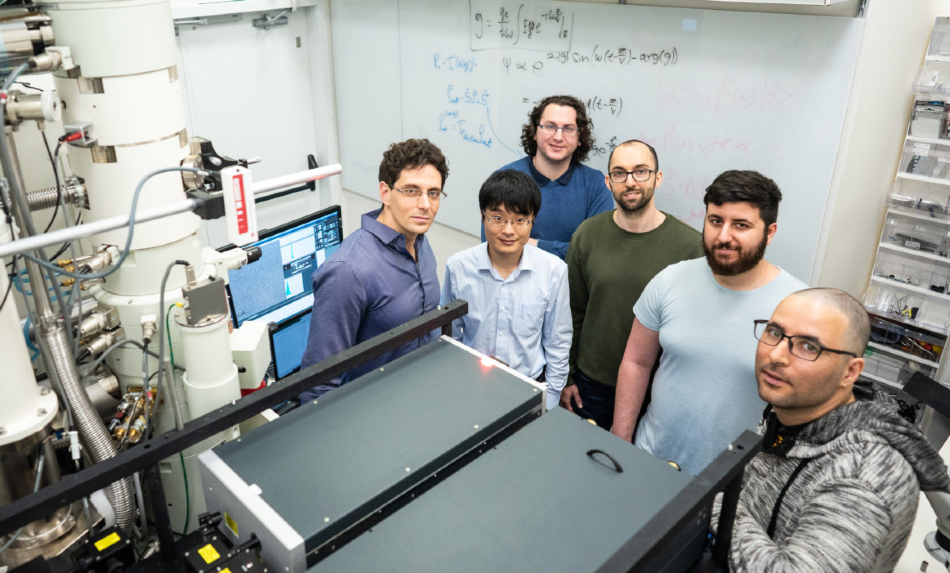Jun 4 2020
A group of researchers, including Professor Ido Kaminer, from Technion-Israel Institute of Technology has made a revolutionary breakthrough in the area of quantum science—a quantum microscope that is capable of recording the flow of light.
 Professor Ido Kaminer (left) with research team. Image Credit: Nitzan Zohar, Technion spokesperson’s office.
Professor Ido Kaminer (left) with research team. Image Credit: Nitzan Zohar, Technion spokesperson’s office.
This breakthrough will help scientists to directly observe the light trapped within a photonic crystal.
The researchers’ study titled “Coherent Interaction Between Free Electrons and a Photonic Cavity” was published in the Nature journal. The team used a special ultrafast transmission electron microscope to perform all the experiments at the Technion-Israel Institute of Technology. The transmission electron microscope is the most versatile and latest of a handful of instruments existing in the scientific realm.
We have developed an electron microscope that produces, what is in many respects, the best near- field optical microscopy in the world. Using our microscope, we can change the color and angle of light that illuminates any sample of nano materials and map their interactions with electrons, as we demonstrated with photonic crystals.
Ido Kaminer, Professor, Technion-Israel Institute of Technology
“This is the first time we can actually see the dynamics of light while it is trapped in nano materials, rather than relying on computer simulations,” stated Dr Kangpeng Wang, the study’s first author and postdoc in the research team.
Professor Kaminer headed all the experiments carried out on the ultrafast transmission electron microscope in the Robert and Ruth Magid Electron Beam Quantum Dynamics Laboratory. He is affiliated with the Helen Diller Quantum Center and the Russell Berrie Nanotechology Institute and is also a faculty member in the Andrew and Erna Viterbi Faculty of Electrical Engineering and the Solid State Institute.
The research group also includes Dr Kangpeng Wang, Raphael Dahan, Michael Shentcis, Dr Yaron Kauffmann, Adi Ben-Hayun, Ori Reinhardt, and Shai Tsesses.
Far-Reaching Applications
This latest breakthrough may have a positive impact on various promising applications, such as the design of novel quantum materials for preserving quantum bits with relatively better stability. With this advancement, the sharpness of colors on mobile phones and other types of screens can also be improved.
It will have an even wider impact once we investigate more advanced nano/quantum materials. We have an extremely high-resolution microscope and we are starting to explore the next stages.
Ido Kaminer, Professor, Technion-Israel Institute of Technology
“For example, the most advanced screens in the world today use QLED technology based on quantum dots, making it possible to control color contrast at a much higher definition. The challenge is how to improve the quality of these tiny quantum dots on large surfaces and make them more uniform. This will enhance screen resolution and color contrast even more than current technologies enable,” elaborated Professor Kaminer.
A New Kind of Quantum Matter
Installed in Professor Kaminer’s AdQuanta laboratory, the ultrafast transmission electron microscope has an acceleration voltage that differs from 40 to 200 kV (speeds up electrons to 30% to 70% the speed of light) and also a laser system that delivers sub-100 fs pulses at 40 W.
The unique ultrafast electron transmission microscope at the Technion-Israel Institute of Technology is a femtosecond pump-probe setup that employs light pulses to stimulate both the electron pulses and the sample for probing the transient state of the sample. These electron pulses enter the sample and subsequently image it. The incorporation of multidimensional capabilities in a single setup is quite useful for the complete characterization of nano-scale objects.
At the core of the latest breakthrough lies the fact that developments in ultrafast free-electron-light interaction research have introduced quantum free-electron “wavepackets”—a new kind of quantum matter.
Earlier, quantum electrodynamics, or QED, explored the interaction between quantum matter and the cavity modes of light. This analysis proved to be significant for developing the fundamental physics that make up the infrastructure of quantum technologies.
But all experiments performed so far have only targeted the interaction of light with bound-electron systems—like atoms, quantum circuits, and quantum dots—which are considerably restricted in their spectral range, fixed energy states, and selection rules. However, no such limitations exist in quantum free-electron wavepackets.
In spite of numerous theoretical predictions of triggering novel cavity effects with free electrons, researchers have not observed any photonic cavity effect in free electrons before. This can be attributed to the underlying limits on the duration and strength of the interaction.
An experimental platform has been developed by Professor Kaminer and his team for the multidimensional analysis of the nanoscale interactions of free electrons with photons.
By using the quantum nature of electrons, the special microscope developed by the researchers accomplished record near-field optical maps. These electrons were validated by visualizing Rabi oscillations of the electron spectrum that otherwise cannot be described only by classical theory.
More efficient interactions between free electrons and cavity photons may enable powerful coupling, new quantum nonlinear phenomena, and photon quantum state synthesis.
The area of electron microscopy and supplementary fields of free-electron physics may benefit from the fusion with photonic cavities, allowing ultrafast, low-dose electron microscopy of various beam-sensitive materials, including soft matter.
Professor Kaminer believes that the new microscope will cater to the broader Technion community working in other fields of research.
I would like to nurture interdisciplinary collaboration.
Ido Kaminer, Professor, Technion-Israel Institute of Technology
The Robert and Ruth Magid Electron Beam Quantum Dynamics Lab is situated in the Electron Microscopy Center in the Technion Faculty of Materials Science and Engineering.
Journal Reference:
Wang, K., et al. (2020) Coherent Interaction Between Free Electrons and a Photonic Cavity. Nature. doi.org/10.1038/s41586-020-2321-x.